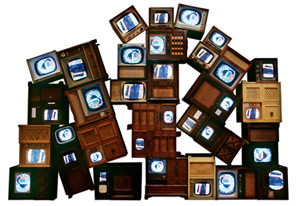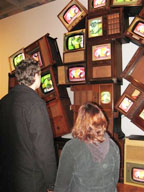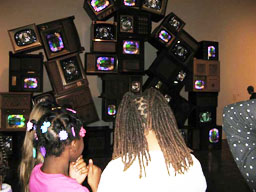The riches of Ruin

It’s impossible to ignore “Ruin,” an assemblage of 32 antique TV cabinets, stacked against the north wall on the main level of the Milwaukee Art Museum. The installation, by Nam June Paik, is part of Sensory Overload, a reinstallation of the contemporary art galleries which opens on January 24 and runs until 2009. Overload promises light, motion, sound and the optical in art since 1945, but I advise the wise to absorb it bit by bit, as if spearing peas from a TV dinner. I followed my own counsel and spent two hours sitting in front of “Ruin” watching 2-channel video flash and wink from the cabinets, mostly turned upside down so that their pedestals would serve as supports for the towering, pyramidal installation. This artist’s world is upside down; should you care to compare, Marquette University’s Haggerty Museum of Art has a Paik installation. “Ruin” would have been a perfect fit for the creepy otherworld of Blade Runner. It’s strangely robotic and detached, but the idea of television and all that the word implies remains highly personal.
Over the years, television became a fixture in homes everywhere – first just one, then maybe two or more. The bigger and flashier the television sets became, it seemed the content worth watching began to shrink. We scraped bottom when a recent televised political “debate” involved YouTube, a Bible and a question about Jesus. But I suppose I stuffed myself on As The World Turns, so who am I to criticize drek?
While plopped in front of “Ruin 2001,” I engaged a trio of students from St. Louis who paused to peruse the blinking installation. They said they don’t watch television, but gave a good explanation of the intricacies of the 2-channel video system and moved closer to see if there was anything “familiar” in the loopy colorful images. “I think I just saw a Star of David flash by,” one of them remarked as he checked for messages on his cell phone. A group of chattering elementary school students led by a docent drifted in, barely giving Paik’s work a nod. I heard one of them ask what it was about, but before due consideration of the work was given, the herd moved on to the next dazzling thing. Perhaps one needs to be at least 40 years old to get Paik’s point. Or perhaps you just need to be able to sit still for a few hours.
 You’ll need to pay attention to discover the artist’s signature on the face of a Fada Radio cabinet weirdly converted to a television. A central stack of cabinets is supported on either side by additional stacks of leaning cabinets (threatening to topple?) bearing witness to the days of RCA Victor, Admiral, General Electric and Motorola. Some have their guts ripped asunder and replaced with Samsung screens. One such cabinet bears the name Hyde Park; another is a monster fruitwood cabinet by Zenith in the “Country French” mode. The entire installation is a global mish-mash, a dinged and dusty icon of where we’ve been, and the concept is brilliant and fascinating, particularly if you’ve been around long enough to grasp the impact television has had on the world. I hoped to see a snippet of Lucy laboring on an assembly line while packing chocolates with Ethel, or if not that, then a glimpse of Captain Kangaroo or Dragnet. The closest I came to a retro-thrill was a speeding flash of a small heart. It was gone in an instant. If you are really curious about “Ruin,” check out the backside’s tangle of wires, cords, and plugs.
You’ll need to pay attention to discover the artist’s signature on the face of a Fada Radio cabinet weirdly converted to a television. A central stack of cabinets is supported on either side by additional stacks of leaning cabinets (threatening to topple?) bearing witness to the days of RCA Victor, Admiral, General Electric and Motorola. Some have their guts ripped asunder and replaced with Samsung screens. One such cabinet bears the name Hyde Park; another is a monster fruitwood cabinet by Zenith in the “Country French” mode. The entire installation is a global mish-mash, a dinged and dusty icon of where we’ve been, and the concept is brilliant and fascinating, particularly if you’ve been around long enough to grasp the impact television has had on the world. I hoped to see a snippet of Lucy laboring on an assembly line while packing chocolates with Ethel, or if not that, then a glimpse of Captain Kangaroo or Dragnet. The closest I came to a retro-thrill was a speeding flash of a small heart. It was gone in an instant. If you are really curious about “Ruin,” check out the backside’s tangle of wires, cords, and plugs.
One can only sit and stare for so long before television burn-out sets in, so I strolled to the nearby Holbrook Gallery of Twentieth Century Design to cool my eyeballs. A towering bookcase by Ettore Sottsass, Jr. (“Carlton,” 1981) has a funky construction similar to Paik’s installation, and like “Ruin” (and the ruin currently known as television viewing), it reminded me that splendid books may soon disappear and nothing will be left to put on splendid shelves.
 Upstairs, in the newly configured Bradley Collection, I visited old favorites re-hung and found myself thinking how hip it all seemed decades ago. A television in Peg Bradley’s sumptuous apartment, now open to the public, was running a video of her, and in one segment, she stood by her car, clad in a funky fur and wearing a short chic dress skimmed with knee-high boots. Outside of the lush, red-red digs, paintings by Karel Appel and Josef Albers and a clutch of Bertoia sculptures conjured memories. A twinge of nostalgia rushed forth, a yearning for the Way Back Days of Executive Director Russell Bowman and Christopher Goldsmith, the two who helped bring the Calatrava to fruition. There is comfort in knowing that “Ruin” was purchased to honor them, and to celebrate the 50th anniversary of The Friends of Art. In March, the museum welcomes a new Executive Director, Daniel Keegan, who promises (more or less) to drag us into the high-tech art arena, while keeping us in touch with the familiar one-on-one experience of considering a single work of art. Sensory Overload is a bridge between what was and what could possibly be. It will entail a delicate balancing act, not unlike the balancing act put together by Mr. Nam June Paik.
Upstairs, in the newly configured Bradley Collection, I visited old favorites re-hung and found myself thinking how hip it all seemed decades ago. A television in Peg Bradley’s sumptuous apartment, now open to the public, was running a video of her, and in one segment, she stood by her car, clad in a funky fur and wearing a short chic dress skimmed with knee-high boots. Outside of the lush, red-red digs, paintings by Karel Appel and Josef Albers and a clutch of Bertoia sculptures conjured memories. A twinge of nostalgia rushed forth, a yearning for the Way Back Days of Executive Director Russell Bowman and Christopher Goldsmith, the two who helped bring the Calatrava to fruition. There is comfort in knowing that “Ruin” was purchased to honor them, and to celebrate the 50th anniversary of The Friends of Art. In March, the museum welcomes a new Executive Director, Daniel Keegan, who promises (more or less) to drag us into the high-tech art arena, while keeping us in touch with the familiar one-on-one experience of considering a single work of art. Sensory Overload is a bridge between what was and what could possibly be. It will entail a delicate balancing act, not unlike the balancing act put together by Mr. Nam June Paik.
Before leaving the Museum, I stopped for a cup of joe in the long narrow galleria on the lake-facing side of Windhover Hall. Frankly, I’m still peeved that café tables and potted palms have replaced the sculptures in that area, but visiting “Ruin” was a firm reminder that everything changes, for better or for worse. A twitchy teen and his twitchy friend sped by my table. The marble hall echoed with their words, “Let’s get outta here and get some Starbucks.”
















